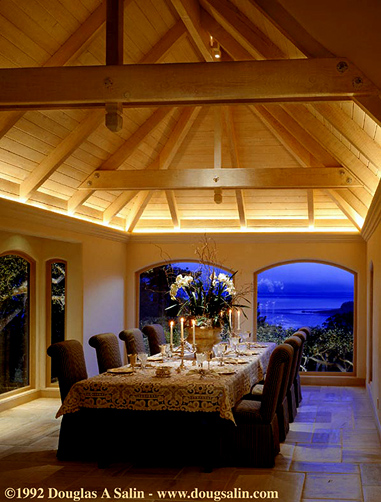

Hi Folks,
This month's Pic of the Month is from 1992. Shot in August, when the weather
in Pebble Beach, CA is pretty foggy.

Client: Capri
/ Thomas Lighting
Lighting Designer: Linda Ferry - Architectural Illumination of Monterey, CA
Interior Design: John Newcomb
Assistant: Ethan Kaplan
Windows present an extra challenge. As the light level drops outside at dusk,
the room interior becomes visible in the windows.
You hope that your added lights and camera are not surprise guests in your carefully
planned shot. The client will not be happy
seeing the photographer or lights reflected in the windows.
Candles present a unique challenge as well. The candles needed about 30 seconds
of exposure to convey the mood and show
enough brightness. The rest of the room needed about 2 minutes of exposure.
The final exposure had to be stopped halfway
through ,and then restarted without the candles. All of the lights in the scene
need to be dimmed to the level of the candles. You
cannot see any of this until the light levels diminish with the sunset. On a
4 x 5 camera the f stop needed is around f32 to capture
all of the focus, both near and far. The picture required multiple exposures.
Some lights are turned off as the exposure progresses.
If the lighting ratios are just right , it all works. There are no second chances.
The type of film used(tungsten balanced), enhances the blue of the dusk. Indoor
lighting is very yellow due to it's nature. Films
that are used to photograph interiors are called Tungsten/Indoor films. To compensate
for the lack of blue light present in indoor
lighting, the manufacturers of these film incorporate an extra blue layer within
the film. Indoor photos done with this type of film
will be more neutral or balanced. But areas that are still affected by the sun/dusk(bluer
light) will have an excess of blue on the
film. So at just the right time during dusk, the blue outside of windows will
intensify and produce a rich effect of beautiful blue. So
part of this blue in the image is the scene, and part of this blue is the film.
The plants outside are lit with flood lights. Of course the circuit breaker
controlling the outside lights blew at showtime(Murphy
is always present). You run and find the circuit breakers. In this case Ethan
did the running. If you are really prepared you ask
where the panel box is, before you begin!
Enjoy the Pic!
Have a warm, serene, and reflective Thanksgiving.
Respectfully,
Doug Salin
Douglas A. Salin Photographer
647 Joost Avenue
San Francisco, CA 94127
415-584-3322
dspeoe@pacbell.net
http://www.dougsalin.com
Links:
Architectural Illumination
Contact: Linda Ferry
Monterey, CA 93942
Phone: 831-622-7111
Fax: 831-622-7411
light@montereybay.com
The image was featured in the lighting books of Randy Whitehead. http://www.randallwhitehead.com/